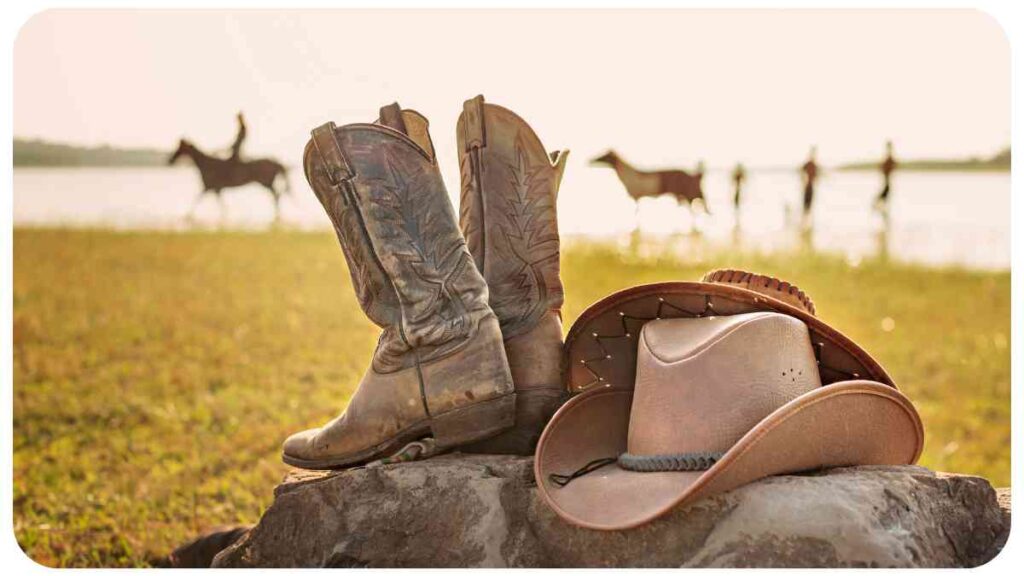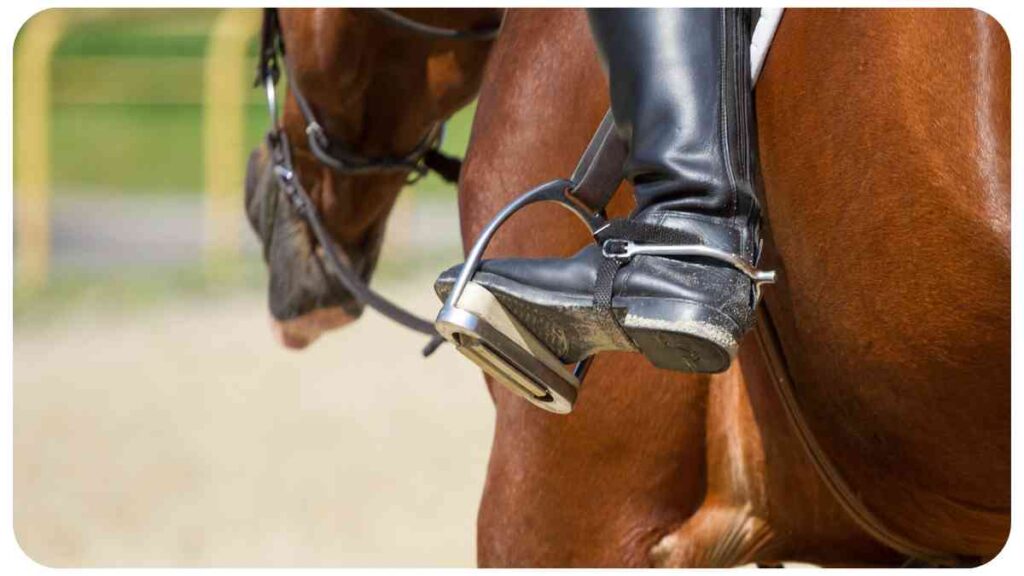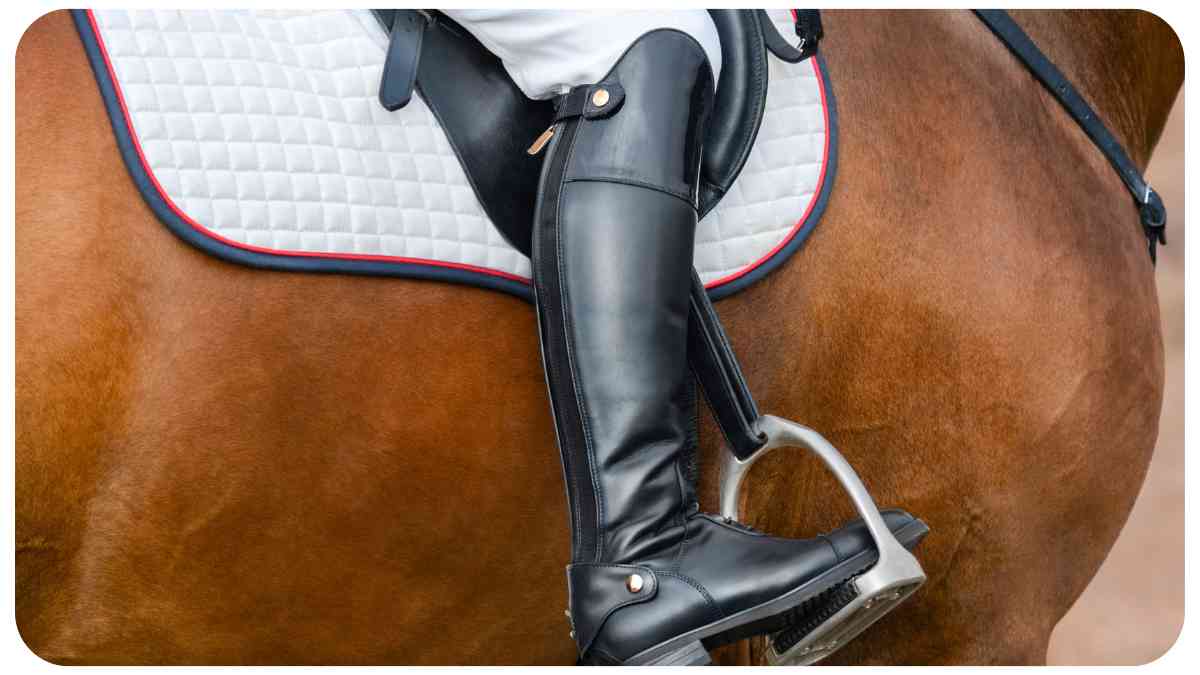Welcome to this guide on how to fix riding boots that don’t fit properly. As a professional with years of experience in the equestrian world, I understand the importance of comfortable and well-fitting boots when it comes to horse riding.
Whether you’re a beginner or an experienced rider, ill-fitting riding boots can not only be uncomfortable but also impact your performance. In this article, I will share practical tips and solutions to ensure your riding boots fit perfectly, allowing you to enjoy your time in the saddle.
| Key Takeaways |
| Riding boots should fit snugly without being too tight or loose. |
| Properly measuring your feet is crucial to finding the right fit. |
| Common signs of ill-fitting boots include discomfort, blisters, and restricted movement. |
| Tight boots can be stretched using sprays or conditioners, and loose boots can be secured with heel grips or inserts. |
| Boot alterations and professional fitting can provide solutions for more significant fit issues. |
| Taking care of your boots through regular cleaning, conditioning, and proper storage helps maintain their fit and durability. |
| Gradually breaking in new boots is important for achieving a comfortable fit. |
| Consider seeking advice from professional boot fitters or consulting fitting guides for additional guidance. |
2. Understanding Proper Fit for Riding Boots
Before diving into ways to fix ill-fitting boots, it’s important to understand what constitutes a proper fit. Riding boots should provide a snug feel without being too tight or loose. They need to allow enough room for your toes to move while providing ample support to your feet, ankles, and calves. Correctly fitted boots enhance your stability, balance, and control while riding.
“Having riding boots that fit properly is crucial to ensure comfortable and safe horseback riding experiences.” Check out our article on the importance of properly fitting horseback riding boots to find out why it matters.
3. Signs of Ill-Fitting Riding Boots

Identifying whether your boots fit poorly is crucial in determining the necessary fixes. Here are some common signs of ill-fitting riding boots:
- Discomfort or pain: If your boots cause discomfort, pain, or soreness during and after riding, chances are they don’t fit properly.
- Blister formation: Frequent blisters or abrasions on your feet, ankles, or calves can indicate that your boots are rubbing or pinching.
- Feet sliding inside the boots: If your feet are constantly sliding inside the boots while riding, it means they are too loose.
- Restricted movement: Boots that are too tight restrict your movement and compromise your ability to flex your ankles and maintain proper balance.
- Gap or overhang: If there is a significant gap or overhang at the top of your boots, they may be too loose or too short for your legs.
4. How to Measure Your Feet for Boots
Properly measuring your feet is the first step in achieving the right fit for your riding boots. Follow these steps to measure your feet accurately:
- Use a Brannock Device: The Brannock Device is the standard tool used to measure foot size. To measure your foot length, place your heel against the back of the device and stretch your foot forward. Take note of the number aligned with the longest toe.
- Measure Foot Width: Use a cloth tape measure to determine the width of your foot at its widest point, usually around the ball of the foot. Make sure the tape measure wraps snugly around your foot without distorting its shape.
“When it comes to riding, choosing the right saddle is just as important as finding the perfect pair of boots.” Dive into our comprehensive guide on choosing the perfect saddle for your horse to ensure a comfortable ride.
5. Common Issues and Solutions
Let’s dive into some common issues riders face with their boots and explore the appropriate solutions for each problem.
Tight Boots
If your riding boots are too tight, causing discomfort or pinching, there are several ways to address this issue:
| Problem | Solution |
| Tight around the toes | Use a boot stretching spray or conditioner to soften the leather. Wear thick socks and insert a wooden shoe stretcher to gradually expand the toe area. |
| Tight around the calf | Look for boots with stretch panels or gussets in the calf area for more flexibility. Consider getting the boots professionally stretched or altered to provide a better fit. |
| Tight around the instep | Apply a leather conditioning product to soften the leather. Use a boot stretcher or insert a stretch spray to help stretch the instep gradually. |
| Boots causing rubs or blisters | Apply moleskin or a gel blister pad to the affected areas to reduce friction and protect your skin. Consider using boot socks with extra padding or investing in silicone heel protectors. |
Remember, gradually stretching the boots is key to avoiding damage and achieving a better fit.
“Safety is paramount in every equestrian activity, and a well-fitted helmet is a must-have.” Discover our review of the top horseback riding helmets of the year and make an informed decision to protect yourself while riding.
Loose Boots
If your boots are too loose, causing your feet to slide inside or impacting your stability while riding, try the following solutions:
| Problem | Solution |
| Boots slipping at the heel | Insert heel grips or adhesive padding to secure your heels in place. Explore heel inserts or insoles designed for riding boots to provide |
Remember, finding the right fit for riding boots is a process of trial and error. It’s important to explore different solutions and adapt them to your unique needs and preferences.
6. Tips for Enhancing Boot Fit
In addition to the specific solutions mentioned above, here are some general tips that can help enhance the fit of your riding boots:
- Breaking them in: Give your boots enough time to break in gradually. Wear them around the house or during short rides to allow the leather to mold to your feet.
- Wear proper socks: Choose socks that are specifically designed for riding. Look for moisture-wicking, breathable materials that provide cushioning and support.
- Consider custom-made boots: If you struggle to find boots that fit perfectly off the shelf, consider investing in custom-made riding boots. These boots are tailored to your precise measurements and ensure a personalized fit.
- Seek professional advice: If you’re unsure about the fit of your boots or prefer personalized guidance, consult a professional boot fitter. They can provide expert advice and perform alterations to ensure a comfortable and secure fit.
7. Stretching Your Riding Boots
Stretching your boots can be an effective way to address minor fit issues. Here are some methods you can use to stretch your riding boots:
- Boot stretching spray or conditioner: Apply a stretching spray or conditioner to soften the leather and make it more pliable. This will allow the boots to stretch more easily.
- Use a boot stretcher: Invest in a boot stretcher, which can help widen the toe box, heel area, or instep of your boots. Insert the stretcher and gradually expand it until you achieve the desired fit.
- Freeze and stretch method: Fill a plastic bag with water, place it inside your boots, and put them in the freezer. As the water freezes and expands, it stretches the leather. Once the ice is completely frozen, remove the boots from the freezer and let the ice thaw before taking out the bags.
Remember to always follow the instructions provided with your stretching products and be cautious not to overstretch your boots, as it may lead to damage.
8. Alterations for Better Fit
When dealing with fit issues that cannot be resolved through simple stretching or padding, professional alterations can be a viable solution. Here are some common alterations that can improve the fit of your riding boots:
- Calf alterations: If the calf area of your boots is too tight, a boot fitter can make alterations by adding elastic panels, gussets, or zippers to provide more flexibility.
- Heel adjustments: Boot fitters can adjust the heel portion of your boots to ensure a snug fit and prevent slippage.
- Sole modifications: In some cases, modifications to the sole can be made to improve stability, comfort, or foot alignment while riding.
Consult with a reputable boot fitter to assess the alterations needed for your specific fit issues and to ensure professional execution.
“Successful horse training begins with solid groundwork, establishing a strong foundation for all future learning.” Learn more about the importance of ground work and develop a successful training regimen for your equine companion.
9. Proper Boot Care

Taking care of your riding boots is essential for maintaining their fit and durability. Here are some tips for proper boot care:
- Cleaning and conditioning: Regularly clean your boots with a damp cloth to remove dirt and sweat. Use a leather conditioner to keep the leather supple and prevent it from drying out and cracking.
- Storage: Store your boots in a cool, dry place away from direct sunlight. Avoid folding or piling them to prevent damage to the shape.
- Boot trees: Invest in boot trees to help maintain the shape and prevent leather from sagging or creasing.
- Waterproofing: Apply a waterproofing agent to protect your boots from moisture and extend their lifespan.
By following these care tips, you can extend the life of your boots while ensuring they continue to provide a comfortable fit.
10. Conclusion
Finding the perfect fit for your riding boots is essential for your comfort, safety, and overall riding experience. By understanding the signs of ill-fitting boots and implementing the solutions provided, you can ensure that your boots fit like a glove.
Remember to properly measure your feet, explore different remedies for common fit issues, and seek professional assistance when needed. With the right fit, you can focus on your riding
“Understanding the judging criteria at horse shows is vital for participants to showcase their skills effectively.” Gain insights into the world of horse shows with our article on the importance of understanding judging criteria and improve your performance in competition.
Further Reading
For more information on how to ensure your riding boots fit properly and find additional tips and advice, check out the following resources:
- How Do I Tell If My Riding Boots Fit?: This blog post provides detailed guidance on how to determine if your riding boots fit and offers helpful tips for achieving the perfect fit.
- Riding Boots Break-in: The Best Tips: Learn about effective ways to break in your riding boots for optimal comfort and fit with this informative article from Horze.
- Riding Boot Repairs: Discover insights and advice on repairing and maintaining your riding boots to extend their lifespan and maintain a proper fit, courtesy of Horse & Hound.
FAQs
Here are some frequently asked questions about fixing ill-fitting riding boots:
Can I stretch my riding boots at home?
Yes, there are several methods you can try to stretch your riding boots at home. Using a boot stretching spray or conditioner, gently stretching the boots with a boot stretcher, or even employing the freeze and stretch method with a plastic bag filled with water are all effective ways to stretch your boots. Just remember to follow the instructions carefully and proceed with caution.
Should I wear thick socks to make tight boots fit?
Wearing thick socks is a common trick to help stretch the leather and provide some extra room in tight boots. The added bulk of the socks can gradually stretch the leather and improve the fit over time. However, keep in mind that wearing excessively thick socks may affect your overall comfort, so find a balance that works for you.
How long does it take to break in new riding boots?
The break-in period for new riding boots can vary depending on the quality of the leather and the individual’s feet. It typically takes a few rides or several hours of wear for the boots to start molding to your feet and become more comfortable. Be patient and give your boots enough time to adjust to your feet before expecting them to be fully broken in.
Can a boot fitter alter the calf width of my boots?
Yes, a professional boot fitter can alter the calf width of your riding boots. They can add elastic panels, gussets, or zippers to provide more flexibility and accommodate different calf sizes. Consulting a professional boot fitter is recommended for complex alterations like changing the calf width.
How often should I clean and condition my riding boots?
It is important to regularly clean and condition your riding boots to keep them in optimal condition. Depending on how frequently you ride and the conditions in which your boots are exposed, aim to clean and condition them every couple of weeks or at least once a month. This helps prevent dirt buildup, maintains the integrity of the leather, and extends the lifespan of your boots.

Hi there! My name is Hellen James, and I’m a horse riding expert. I’ve been riding horses since I was just a kid—and it’s been my passion ever since. But getting started with horse riding can be overwhelming. There’s so much to learn! If you’re looking for a way to get started and make sure you’re doing it right, I’m here to help.


